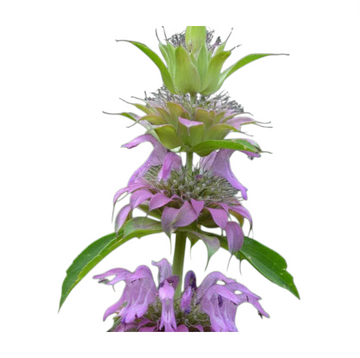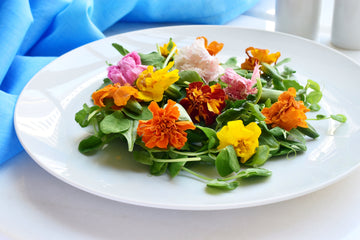Bee Balm Lemon Mint

Freshly Harvested

Non-GMO & Natural

Nutrient Dense

Trusted by Chefs
25 Seeds+
🌸 Bee Balm Lemon Mint Edible Flower Seeds
Monarda citriodora
A pollinator’s paradise 🐝🦋 and a chef’s aromatic delight 👨🍳🌿. Bee Balm Lemon Mint dazzles with lavender-purple blooms stacked in whorls, releasing a bright lemony-mint fragrance 🍋🌱. Long treasured by Indigenous peoples and herbalists, this hardy annual doubles as a culinary flower and a natural garden companion — bringing color, fragrance, and nonstop pollinator activity to your space.
👅 Flavor Profile:
Bright lemon 🍋, cooling mint 🌱, and subtle oregano-like spice 🌶️.
🍴 Culinary Uses:
🥗 Scatter petals over salads for citrusy zing
🍸 Infuse flowers in cocktails, syrups, or teas for lemon-mint notes
🥖 Flavor breads, butters, and herbal spreads with crushed blooms
🧁 Use as edible decoration for cakes & desserts
🍲 Add leaves & petals to soups or marinades for herbal brightness
👨🍳 Chef’s Pitch:
Bee Balm Lemon Mint is the edible flower that works double-time 🌸👨🍳✨. Its lavender blooms are plate-ready garnishes, while the petals and leaves carry a lemon-mint punch chefs love in teas, cocktails, and condiments. Beautiful, aromatic, and versatile — the perfect floral accent for modern kitchens and mixology.
🌱 Growing Notes:
🪴 Annual herb, 24–30” tall, branching with stacked whorled flowers
🌼 Blooms lavender-purple with striking layered form
⏱ Flowers mid-summer to frost, long bloom season
🐝 Bee, butterfly, and hummingbird magnet
🌞 Thrives in full sun, tolerates dry soil once established
✨ Quick Facts:
-
Latin Name: Monarda citriodora
-
Habit: Annual, 24–30” tall
-
Flavor: Lemon-mint with herbal spice
-
Culinary Uses: Teas, cocktails, salads, desserts, breads, marinades
-
Companion Planting: Attracts pollinators, deters pests, aromatic herb for mixed beds

Bee Balm Lemon Mint

Let’s Manifest Beauty.
Edible Flowers that Smile.
Edible flowers are more than just decoration — they’re a chef’s secret for adding elegance, fragrance, and subtle flavor to a dish. From citrusy marigolds to honey-sweet alyssum and tangy begonias, these delicate blooms transform plates into experiences. Each petal offers color, aroma, and taste, turning simple ingredients into a culinary statement.

Flowers are here to stay
The Art of Garnishing with Edible Flowers
A garnish should do more than decorate — it should enhance. Edible flowers bring color, fragrance, and subtle flavor to the plate, turning simple dishes into memorable experiences. From delicate petals scattered across a salad to a single bloom crowning a dessert, flowers add elegance and elevate presentation in ways that engage every sense.
The Secret Ingredient Chefs Trust
Widely used in professional kitchens, microgreens enhance flavor profiles while adding nutrition and a striking visual appeal to everything from sandwiches to fine dining creations.
Frequent Asked Questions
Q: What are Microgreens?
Microgreens are young, tender plants harvested just after the first leaves develop. They’re packed with flavor, color, and nutrients, making them both delicious and healthy.
Q: Are microgreens really more nutritious than regular vegetables?
Yes. Research shows that microgreens can contain up to 40x more vitamins and antioxidants (like A, C, K, and E) compared to their mature counterparts.
Q: How do I use microgreens in my meals?
They’re incredibly versatile—use them as a garnish, in salads, on sandwiches, in wraps, smoothies, soups, or even as a centerpiece ingredient in gourmet dishes.
Q: How long do microgreens stay fresh?
Stored properly in a fridge, microgreens typically last 5–7 days. To keep them at peak freshness, store them dry in a breathable container.









